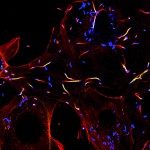Lien vers Pubmed [PMID] – 24979648
Oncotarget 2014 Jul;5(14):5304-19
Trastuzumab is established as treatment of HER2high metastatic breast cancers but many limitations impair its efficacy. Here, we report the design of a Fab-like bispecific antibody (HER2bsFab) that displays a moderate affinity for HER2 and a unique, specific and high affinity for FcγRIII. In vitro characterization showed that ADCC was the major mechanism of action of HER2bsFab as no significant HER2-driven effect was observed. HER2bsFab mediated ADCC at picomolar concentration against HER2high, HER2low as well as trastuzumab-refractive cell lines. In vivo HER2bsFab potently inhibited HER2high tumor growth by recruitment of mouse FcγRIII and IV-positive resident effector cells and more importantly, exhibited a net superiority over trastuzumab at inhibiting HER2low tumor growth. Moreover, FcγRIIIA-engagement by HER2bsFab was independent of V/F158 polymorphism and induced a stronger NK cells activation in response to target cell recognition. Thus, taking advantage of its epitope specificity and affinity for HER2 and FcγRIIIA, HER2bsFab exhibits potent anti-tumor activity against HER2low tumors while evading most of trastuzumab Fc-linked limitations thereby potentially enlarging the number of patients eligible for breast cancer immunotherapy.
